Solutions de redondance avec HSR et PRP
Pour assurer la redondance dans les systèmes d'automatisation des sous-stations, il est très important de prendre en compte le protocole de redondance parallèle (PRP) et la redondance transparente à haute disponibilité (HSR). Des organisations telles que la IEC les ont identifiés comme étant les solutions privilégiées pour les environnements de sous-stations
Cette page présente des exemples d'applications qui utilisent soit le PRP, soit le HSR, soit une combinaison des deux pour créer des réseaux de données redondants et efficaces.
Protocole de redondance parallèle
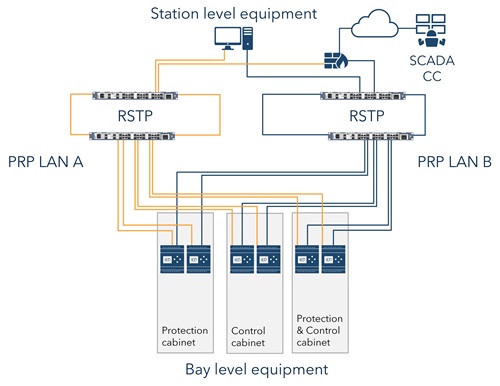
Cliquez pour obtenir une image haute résolution
Le PRP, un protocole de couche 2, assure la redondance et la fiabilité en utilisant deux réseaux indépendants (illustrés en jaune et bleu). Chaque appareil envoie des paquets en double sur les deux réseaux, garantissant ainsi une communication continue même en cas de défaillance d'un réseau. Chaque réseau local fonctionne en parallèle à l'aide du protocole RSTP (Rapid Spanning Tree Protocol).
Pour mettre en œuvre le PRP, les appareils doivent disposer de deux ports réseau et être capables de gérer le PRP au niveau logiciel.
La duplication complète des réseaux locaux (LAN) est assez simple et offre une grande redondance. Elle peut toutefois s'avérer assez coûteuse à mettre en place, car elle nécessite de nombreux appareils dotés de nombreux ports.
Le PRP est adapté aux applications critiques où une haute disponibilité est essentielle. Il garantit que la communication reste ininterrompue même dans le cas improbable d'une défaillance du réseau.
Redondance transparente à haute disponibilité
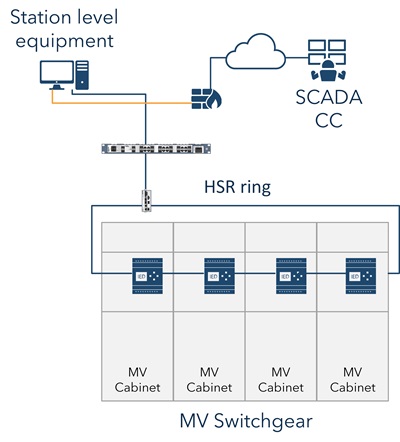
Cliquez pour obtenir une image haute résolution
HSR assure une basculement sans délai en formant une topologie en anneau logique où chaque appareil est connecté à deux autres appareils, créant ainsi une boucle physique. Cela garantit que la communication peut se poursuivre même en cas de défaillance imprévue de la connexion.
La topologie en anneau du HSR offre certains avantages par rapport au PRP, tels qu'une densité de ports réduite dans les commutateurs, ce qui simplifie l'installation. Cependant, cela implique que les appareils doivent prendre en charge le HSR et que la redondance est conçue pour gérer une seule défaillance dans l'anneau. Dans le cas improbable de défaillances multiples, l'impact sur le réseau sera plus important qu'avec une solution PRP. De plus, la solution en anneau introduit des latences dans la communication, ce qui peut poser problème dans les applications où le temps est un facteur critique, en particulier lorsqu'elles dépendent du PTP/IEEE1588.
Combinaison de HSR et PRP
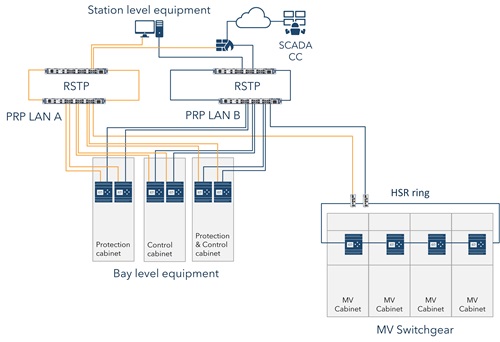
Cliquez pour obtenir une image haute résolution
Le PRP et le HSR ont des objectifs différents, et leur combinaison peut déboucher sur des solutions plus avancées
Il existe plusieurs façons de combiner les topologies PRP et HSR afin d'obtenir des niveaux supplémentaires de redondance. Cet exemple implique l'utilisation d'une topologie en anneau HSR pour connecter les appareillages de commutation moyenne tension et d'une topologie PRP pour connecter les équipements au niveau de la station. L'anneau HSR connecte les appareils selon une topologie en anneau, tandis que la topologie PRP fournit des chemins parallèles pour la redondance.
Redundancy Box
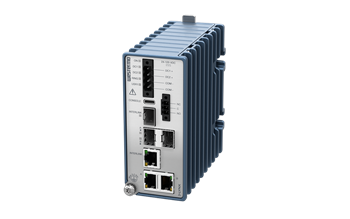
Les boîtiers de redondance (Red Box) sont utilisés pour fournir une redondance aux nœuds d'extrémité qui ne sont pas équipés de deux ports réseau, communément appelés nœuds à connexion unique (SAN).
Une RedBox relie le réseau HSR et le réseau PRP. Elle garantit que les données sont correctement transmises entre les deux réseaux sans duplication. La communication est gérée par la RedBox qui identifie et trie les télégrammes en fonction de leur origine et de leur destination
Certifié pour les applications critiques
Applications pour sous-stations
Notre gamme d'appareils offre une perte de paquets nulle pour des applications sans erreur et sans interruption, tout en sécurisant les sous-stations contre les cybermenaces. Quels que soient vos besoins en matière d'applications, Westermo a la solution qu'il vous faut.
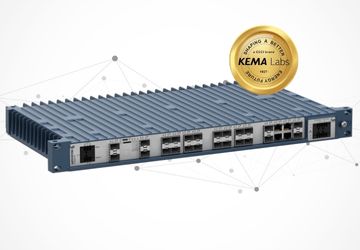
RedFox-5728 Commutateur de sous-station
Fiabilité de communication renforcée pour les postes. Le RedFox-5728 dépasse les exigences de la norme IEC 61850-3 Classe 2.
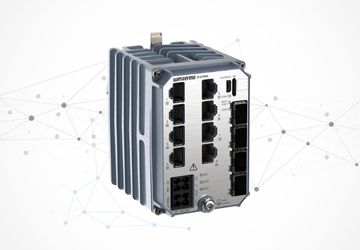
Lynx-5612 Commutateur de sous-station
Le switch haute performance le plus compact, conforme IEC 61850-3 classe 1, montage sur rail DIN et 12 ports gigabit.
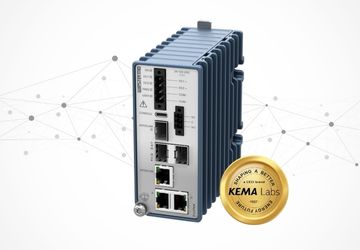
Boîtier de redondance Lynx
Appareil compact 3 ports conçu pour l’automatisation des postes, destiné aux réseaux redondants Zero Failover pour applications critiques
Cas d'utilisation de la boîte de redondance
Ajouter une redondance à un nœud unique connecté (SAN) et se connecter à un réseau PRP
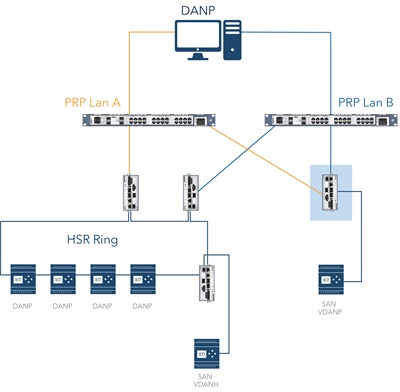
Cliquez pour obtenir une image haute résolution
Dans ces applications, une unité ne disposant que d'un seul port réseau accessible doit être connectée à un réseau PRP afin d'assurer la redondance.
Ceci est réalisé en utilisant le Boîtier de redondance Lynx (RedBox) qui permet de connecter l'unité aux réseaux PRP Lan A et Lan B.
Les périphériques SAN sont désormais connectés en tant que nœuds de réseau double virtuel (VDANP).
Ajouter une redondance à un nœud unique connecté (SAN) et se connecter à un réseau HSR
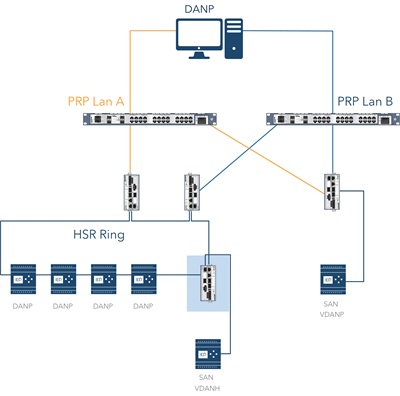
Cliquez pour obtenir une image haute résolution
Dans cet exemple, un nœud unique connecté, dépourvu de fonctionnalités de redondance inhérentes, doit être connecté à un réseau HSR. Le SAN peut être la connexion SCADA, le réseau au niveau de la station ou un périphérique hérité.
Un anneau HSR nécessite que tous les périphériques de l'anneau prennent entièrement en charge HSR. Le Boîtier de redondance Lynx (RedBox) rend le SAN redondant et prend en charge son intégration dans le réseau.
Les périphériques SAN sont désormais connectés en tant que nœud réseau double virtuel HSR (VDANH)
Interconnexion HSR et PRP
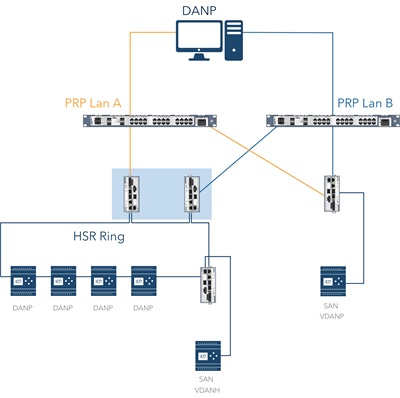
Cliquez pour obtenir une image haute résolution
La combinaison de HSR et PRP peut être avantageuse pour créer un réseau robuste et redondant à haute disponibilité.
Les appareils connectés via HSR forment une topologie en anneau. Deux boîtiers de redondance gèrent la traduction et le transfert des paquets entre l'anneau HSR et le réseau PRP. Ils garantissent que les paquets sont correctement dupliqués et envoyés sur les réseaux A et B du PRP, tout en préservant l'intégrité de l'anneau HSR.
IEC 61850
La norme CEI 61850 détaille dans le rapport technique 90-4 Réseaux et systèmes de communication pour l'automatisation des services publics d'électricité les directives d'ingénierie réseau pour l'automatisation des sous-stations. Les protocoles de redondance choisis dans la norme CEI 61850-9-2 sont HSR et PRP.
Terminologie relative à la redondance
David Åkerman
Global Market Director, Energy

Pour toute requête technique, merci de vous orienter vers le contact support
